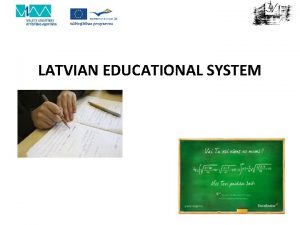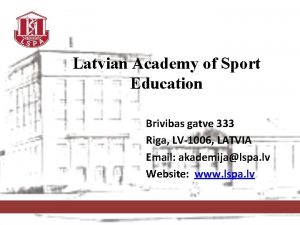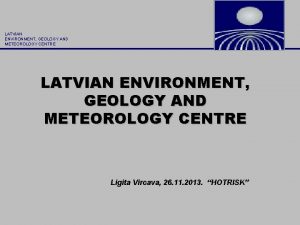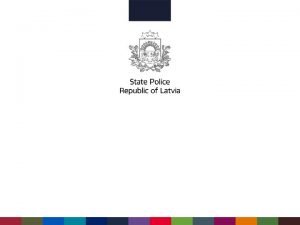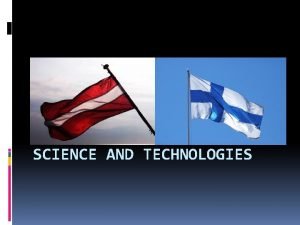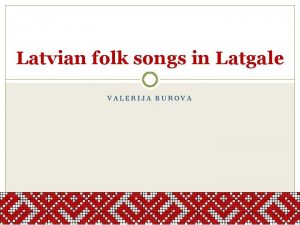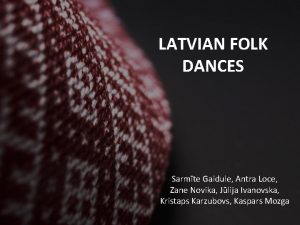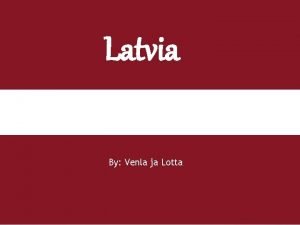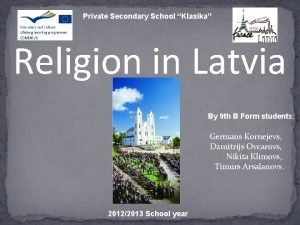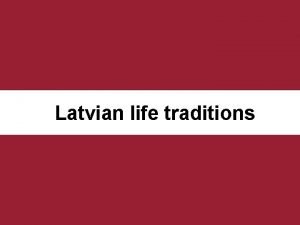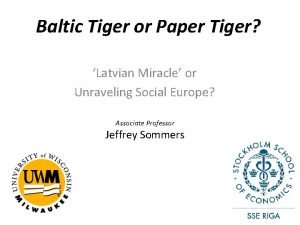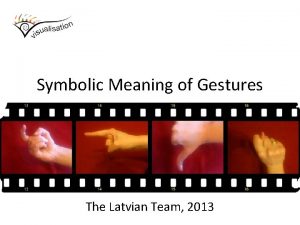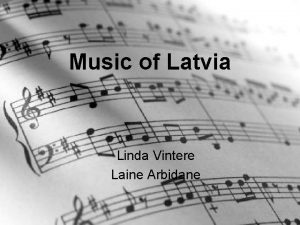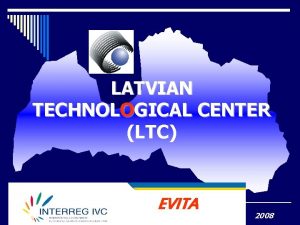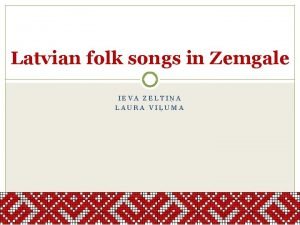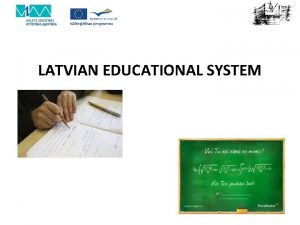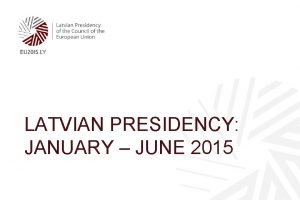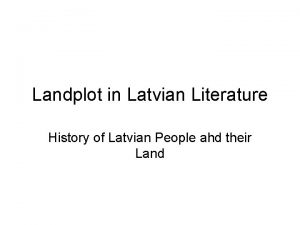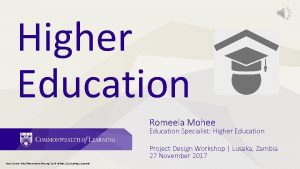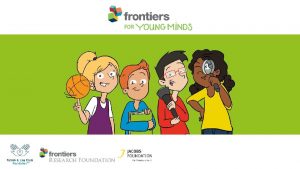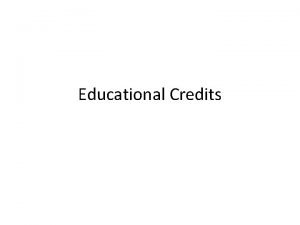LATVIAN EDUCATIONAL SYSTEM SCHOOL EDUCATION AND HIGHER EDUCATION














- Slides: 14

LATVIAN EDUCATIONAL SYSTEM

SCHOOL EDUCATION AND HIGHER EDUCATION School education After nine years of basic education, secondary education is provided in general secondary schools (3 years), vocational schools (2 to 3 years), and vocational secondary schools (4 years). General secondary schools award the Certificate of General Secondary Education. Vocational schools (2 -3 years) award Certificates of Vocational Education. Vocational secondary schools award a Diploma of Vocational Secondary Education which is also valid for university entrance. Higher education There are 34 state recognized higher education institutions in Latvia. All the recognized institutions enjoy autonomy. Recognition of higher education institutions and programmes are based upon quality assessment, which is carried out as self-assessment followed by an evaluation visit with the participation of foreign experts. Higher education institutions confer academic degrees and professional higher education qualifications. Academic higher education programmes are based upon fundamental and/or applied science; they usually comprise a thesis at the end of each stage and lead to the degrees of Bachelor and Master. The Bachelor degree is awarded after completion of the first stage of studies. Since 2001, professional Bachelor and Master can also be awarded. The degree of Master (or its equivalent) is required for admission to doctoral studies. According to the Law on Professional Education and the Law on Higher Education Establishments there are several types of higher professional education programmes in Latvia - first-level professional higher education programmes (also called college programmes) and second level professional higher education programmes which are considered as "completed" professional higher education and lead to the second-level professional higher education.

DIAGRAM OF LATVIAN EDUCATIONAL SYSTEM 16 15 14 13 12 11 10 9 8 7 6 5 4 3 2 1 SECONDARY SCHOOLS VOCATIONAL SCHOOLS BASIC SCHOOLS PRIMARY/ELEMENTARY SCHOOLS PRE-SCHOOL (KINDERGARTEN) TERTIARY LEVEL ADULT EDUCATION 19 18 17 HIGHER EDUCATION ESTABLISHMENT SPECIAL EDUCATION 21 20 SECONDARY LEVEL 24 and more 23 22 Level PRIMARY LEVEL Theoretical age

Primary Education Latvian education is compulsory and free for children between ages 5 and 18. The first 9 years are spent in primary schools that provide a basic academic education.

SCHOOL SUBJECTS THAT ARE TAUGHT FROM GRADE 1 -12 Subject/ grades Mathematics Latvian language Ethics Dancing Visual arts Science Music Housekeeping History Biology Social English German or Russian Informatics Geography Chemistry Physics Education Economics Cultural history Policy and Law Psychology Sports 1 2 3 4 5 6 7 8 9 10 11 12 x x x x x x x x x x x x x x x x x x x x x x x x x x x x x x x x x x x x x x x * x x x * * * * *

Secondary Education For the final three years of their schooling, academically-minded pupils may continue on to general secondary schools where they complete their university preparation by sitting for their certificate of general secondary education. Those with a more practical view on life choose vocational secondary schools instead, that culminate in certificates of vocational education.

SCHOOL SUBJECTS THAT ARE TAUGHT FROM GRADE 1 -12 Subject/ grades Mathematics Latvian language Ethics Dancing Visual arts Science Music Housekeeping History Biology Social English German or Russian Informatics Geography Chemistry Physics Education Economics Cultural history Policy and Law Psychology Sports 1 2 3 4 5 6 7 8 9 10 11 12 x x x x x x x x x x x x x x x x x x x x x x x x x x x x x x x x x x x x x x x * x x x * * * * *

STRUCTURE OF THE LATVIAN EDUCATION SYSTEM BASIC Type of school providing this education Length of program in years Age level, from__to__ Certificate/ diploma awarded Basic School BASIC VOCATIONAL Vocational Basic School GENERAL VOCATIONAL SECONDARY General Secondary School, Gymnasium Vocational Secondary School. Vocational Gymnasium VOCATIONAL Vocational School 9 2 3 4 3 7 - 15 16 - 18 16 - 19 15 - 18 Certificate of Basic Education Certificate of Basic Vocational Education Certificate of General Secondary Education Diploma of Secondary Vocational Education Certificate of Vocational Education

Vocational Education Latvia has introduced a strategy of continuous vocational training which embraces the concept of life-long learning in order for everybody to remain up-to-date in job-related knowledge. It is hoped that soon half a million people will be participating in these paid programs every year.

DIAGRAM OF LATVIAN EDUCATIONAL SYSTEM 16 15 14 13 12 11 10 9 8 7 6 5 4 3 2 1 SECONDARY SCHOOLS VOCATIONAL SCHOOLS BASIC SCHOOLS PRIMARY/ELEMENTARY SCHOOLS PRE-SCHOOL (KINDERGARTEN) TERTIARY LEVEL ADULT EDUCATION 19 18 17 HIGHER EDUCATION ESTABLISHMENT SPECIAL EDUCATION 21 20 SECONDARY LEVEL 24 and more 23 22 Level PRIMARY LEVEL Theoretical age

Higher Education There are 34 state-recognized higher education institutions, including colleges that offer programs of 2 to 3 year’s duration, and universities offering academic training leading to bachelor’s and master’s degrees.

STAGES OF STUDIES Non-university level post-secondary studies (technical/vocational type) Non-university level: Since 1999, studies in "college programs" of two- to three-years' duration leading to a first-stage higher professional education Diploma are available. These lead to Level IV professional qualifications. Holders are eligible to continue their studies towards the Bachelor' degree or a (full) Higher Professional Education Diploma. Second level professional higher education comprises professional higher education study programs lasting between four and six years. University level studies University level first stage: Undergraduate: The first cycle leads to the award of a Bachelor' degree, which in most cases includes the preparation of a thesis. The duration of studies varies from three to four years. Holders are eligible for further studies towards a Master's degree or higher professional education qualifications. University level second stage: Postgraduate: The second cycle leads to the award of the Master's degree, a terminal qualification of higher education awarded one to two years after the Bachelor' degree. This degree also includes the presentation of a thesis. The total duration of the course of study is no less than five years. In Medicine and Dentistry, studies are not divided into two stages but the degree in Medicine - six years – and degree in Dentistry - five years- are considered equivalent to the Master's degree. University level third stage: Doctorate: Doctoral studies are available at both higher education institutions and research institutes. A Doctor's degree is awarded three to four years after completion of the Master's degree and following the public defense of a thesis.

The oldest of higher education institutions is Riga Technical University founded in 1862 and previously known as Riga Polytechnicum. In additional to a flourishing business school, it has faculties of Architecture & Urban Planning, Building & Civil Engineering, Computer Science & Information Technology, Electronics & Telecommunications, Engineering Economics, Materials Science & Applied Chemistry, Power & Electrical Engineering, and finally Transport & Mechanical Engineering. Higher education in Jelgava has deep roots, reaching back to the time of the foundation of the "Academia Petrina" in 1775. These traditions are indirectly inherited by the Latvia University of Agriculture. Since 1936 the Jelgava Palace has been the main building of the University, and now the destinies of the Palace and the University are closely linked, for they have become as one. The Baroque palace, designed by the famous architect Francesco Bartolomeo Rastrelli, is the pride and the dominant architectural feature of Jelgava.

 Latvia school system
Latvia school system Latvian academy of sport education
Latvian academy of sport education Latvian environment, geology and meteorology centre
Latvian environment, geology and meteorology centre Latvian state police
Latvian state police Latvian inventions
Latvian inventions Latvian folk songs
Latvian folk songs Latvian folk dances
Latvian folk dances Riika väkiluku
Riika väkiluku Religion in latvia
Religion in latvia Krustabas
Krustabas Latvian miracle
Latvian miracle Latvian symbols meaning
Latvian symbols meaning Traditional latvian music
Traditional latvian music Latvian technological center
Latvian technological center Ieva viļuma
Ieva viļuma
